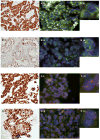Screening for ROS1 gene rearrangements in non-small-cell lung cancers using immunohistochemistry with FISH confirmation is an effective method to identify this rare target
- PMID: 27599111
- PMCID: PMC5225047
- DOI: 10.1111/his.13076
Screening for ROS1 gene rearrangements in non-small-cell lung cancers using immunohistochemistry with FISH confirmation is an effective method to identify this rare target
Abstract
Aims: To assess the prevalence of ROS1 rearrangements in a retrospective and prospective diagnostic Australian cohort and evaluate the effectiveness of immunohistochemical screening.
Methods and results: A retrospective cohort of 278 early stage lung adenocarcinomas and an additional 104 prospective non-small-cell lung cancer (NSCLC) cases referred for routine molecular testing were evaluated. ROS1 immunohistochemistry (IHC) was performed (D4D6 clone, Cell Signaling Technology) on all cases as well as fluorescence in-situ hybridization (FISH) using the ZytoVision and Abbott Molecular ROS1 FISH probes, with ≥15% of cells with split signals considered positive for rearrangement. Eighty-eight cases (32%) from the retrospective cohort showed staining by ROS1 IHC, and one case (0.4%) showed ROS1 rearrangement by FISH. Nineteen of the prospective diagnostic cases showed ROS1 IHC staining, 12 (12%) cases of which were confirmed as ROS1 rearranged by FISH. There were no ROS1 rearranged cases that showed no expression of ROS1 with IHC. The ROS1 rearranged cases in the prospective cohort were all EGFR wild-type and anaplastic lymphoma kinase (ALK) rearrangement-negative. The sensitivity of ROS1 IHC in the retrospective cohort was 100% and specificity was 76%.
Conclusions: ROS1 rearrangements are rare events in lung adenocarcinomas. Selection of cases for ROS1 FISH testing, by excluding EGFR/ALK-positive cases and use of IHC to screen for potentially positive cases, can be used to enrich for the likelihood of identifying a ROS1 rearranged lung cancer and prevent the need to undertake expensive and time-consuming FISH testing in all cases.
Keywords: c-ros oncogene 1 (ROS1); fluorescence in-situ hybridization (FISH); immunohistochemistry (IHC); non-small-cell lung cancer (NSCLC).
© 2016 John Wiley & Sons Ltd.
Conflict of interest statement
W. Cooper has participated in Lung Cancer Advisory Boards and has received honoraria from Pfizer Oncology. S. O’Toole has received honoraria from Roche, Pfizer, and Lilly Oncology. A. Gill has received honoraria from Pfizer Oncology and Astra Zeneca. N. Pavlakis has participated in Lung Cancer Advisory Boards for Pfizer, and received honoraria. The other authors state that they have no conflicts of interest.
Figures

Similar articles
-
On the relevance of a testing algorithm for the detection of ROS1-rearranged lung adenocarcinomas.Lung Cancer. 2014 Feb;83(2):168-73. doi: 10.1016/j.lungcan.2013.11.019. Epub 2013 Dec 1. Lung Cancer. 2014. PMID: 24380695
-
Concordance of Immunohistochemistry and Fluorescence In Situ Hybridization in the Detection of Anaplastic Lymphoma Kinase (ALK) and Ros Proto-oncogene 1 (ROS1) Gene Rearrangements in Non-Small Cell Lung Carcinoma: A 4.5-Year Experience Highlighting Challenges and Pitfalls.Arch Pathol Lab Med. 2024 Aug 1;148(8):928-937. doi: 10.5858/arpa.2023-0229-OA. Arch Pathol Lab Med. 2024. PMID: 38054562
-
Comparison of detection methods and follow-up study on the tyrosine kinase inhibitors therapy in non-small cell lung cancer patients with ROS1 fusion rearrangement.BMC Cancer. 2016 Aug 4;16:599. doi: 10.1186/s12885-016-2582-9. BMC Cancer. 2016. PMID: 27488371 Free PMC article.
-
Biomarkers for ALK and ROS1 in Lung Cancer: Immunohistochemistry and Fluorescent In Situ Hybridization.Arch Pathol Lab Med. 2018 Aug;142(8):922-928. doi: 10.5858/arpa.2017-0502-RA. Epub 2018 Jun 14. Arch Pathol Lab Med. 2018. PMID: 29902067 Review.
-
ALK and ROS1 testing on lung cancer cytologic samples: Perspectives.Cancer Cytopathol. 2017 Nov;125(11):817-830. doi: 10.1002/cncy.21899. Epub 2017 Jul 25. Cancer Cytopathol. 2017. PMID: 28743163 Review.
Cited by
-
Analysis of real-word mutations of lung cancer driver genes in five regions of China.Transl Cancer Res. 2019 Nov;8(7):2581-2592. doi: 10.21037/tcr.2019.10.28. Transl Cancer Res. 2019. PMID: 35117015 Free PMC article.
-
A Real-World Experience from a Single Center (LPCE, Nice, France) Highlights the Urgent Need to Abandon Immunohistochemistry for ROS1 Rearrangement Screening of Advanced Non-Squamous Non-Small Cell Lung Cancer.J Pers Med. 2023 May 10;13(5):810. doi: 10.3390/jpm13050810. J Pers Med. 2023. PMID: 37240980 Free PMC article.
-
Detection of ROS1 rearrangement in non-small cell lung cancer: current and future perspectives.Lung Cancer (Auckl). 2017 Jul 7;8:45-55. doi: 10.2147/LCTT.S120172. eCollection 2017. Lung Cancer (Auckl). 2017. PMID: 28740441 Free PMC article. Review.
-
The rapidly changing field of predictive biomarkers of non-small cell lung cancer.Pathol Oncol Res. 2024 Jun 17;30:1611733. doi: 10.3389/pore.2024.1611733. eCollection 2024. Pathol Oncol Res. 2024. PMID: 38953007 Free PMC article. Review.
-
"Evaluation of ROS1 expression and rearrangements in a large cohort of early-stage lung cancer".Diagn Pathol. 2023 May 27;18(1):70. doi: 10.1186/s13000-023-01357-1. Diagn Pathol. 2023. PMID: 37237384 Free PMC article.
References
-
- Ou S-HI, Tan J, Yen Y, Soo RA. ROS1 as a “druggable” receptor tyrosine kinase: lessons learned from inhibiting the ALK pathway. Expert Rev Anticancer Ther. 2012 Apr;12(4):447–56. - PubMed
-
- Uttamsingh S, Zong CS, Wang L-H. Matrix-independent activation of phosphatidylinositol 3-kinase, Stat3, and cyclin A-associated Cdk2 Is essential for anchorage-independent growth of v-Ros-transformed chicken embryo fibroblasts. J Biol Chem. 2003 May 23;278(21):18798–810. - PubMed
MeSH terms
Substances
Grants and funding
LinkOut - more resources
Full Text Sources
Other Literature Sources
Medical
Research Materials
Miscellaneous

